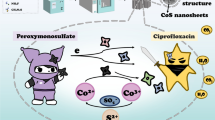Abstract
A dichloromethane (DCM)-degrading bacterium, Ralstonia metallidurans PD11 NBRC 101272, was immobilized in a polyvinyl alcohol (PVA) gel to use in a bioreactor for DCM treatment. After 4-month incubation of PVA gel beads with R. metallidurans PD11 and DCM in a mineral salt medium, the cells were tightly packed in the mesh of the gel. Forty beads of the gel in 10 ml of a batch system model showed effective activity degrading 500 and 1,000 mg l−1 DCM within 2 and 3 h, respectively. Although reduction of pH due to accumulation of chloride ion liberated from DCM decreased the activity, it was recovered by adjustment to neutral pH. The activity of the immobilized cells was not affected by addition of nutrients which were preferentially utilized by R. metallidurans PD11, unlike the activity of the free-living cells. A continuous flow system with a column was more effective for rapid degradation of DCM. Thus, the PVA gel–immobilized cell of R. metallidurans PD11 is thought to be a prospective candidate to develop the bioreactor.






Similar content being viewed by others
References
Aizpuru A, Malhautier L, Roux C, Fanlo L (2003) Biofiltration of a mixture of volatile organic compounds on granular activated carbon. Biotechnol Bioeng 83:479–488
Brunner W, Staub D, Leisinger T (1980) Bacterial degradation of dichloromethane. Appl Environ Microbiol 40:950–958
Jonsson F, Jhanson G (2001) A Bayesian analysis of the influence of GSTT1 polymorphism on the cancer risk estimate for dichloromethane. Toxicol Appl Pharmacol 174:99–112
Kawata H, Nakayama C, Sakamoto M, Ikatsu H, Miyoshi S, Tomochika K, Shinoda S (2000) Isolation of dichloromethane-degrading bacteria from drainage water. J Health Sci 46:187–191
Landi S (2000) Mammalian class theta GST and differential susceptibility to carcinogens: a review. Mutat Res 463:247–283
Leisinger T, Braus-Stromeyer SA (1995) Bacterial growth with chlorinated methanes. Environ Health Perspect 103:33–36
Lowry OH, Rosebrough NJ, Farr AL, Randall RJ (1951) Protein measurement with the Folin phenol reagent. J Biol Chem 193:265–275
Mattick KL, Rowbury RJ, Humphrey TJ (2003) Morphological changes to Escherichia coli O157:H7, commensal E. coli and Salmonella spp. in response to marginal growth conditions, with special reference to mildly stressing temperatures. Sci Prog 86: 103–113
Miyake-Nakayama C, Masujima S, Ikatsu H, Miyoshi S, Shinoda S (2004) Isolation and characterization of a new dichloromethane degradation bacterium, Ralstonia metallidurans PD11. Biocontrol Sci 9:89–93
Okkerse WJH, Ottengraf SPP, Osinga-Kuipers B, Okkerese M (1999) Biomass accumulation and clogging in biotrickling filters for waste gas treatment. Evaluation of a dynamic model using dichloromethane as a model pollutant. Biotechnol Bioeng 63:418–430
Serota DG, Thakur AK, Ulland BM, Kirschman JC, Brown NM, Coots RH, Morgareidge K (1986a) A two-year drinking-water study of dichloromethane in rodents. I Rats Food Chem Toxicol 24:951–958
Serota DG, Thakur AK, Ulland BM, Kirschman JC, Brown NM, Coots RH, Morgareidge K (1986b) A two-year drinking-water study of dichloromethane in rodents. II Mice Food Chem Toxicol 24:959-963
Viollier PH, Weihofen A, Folcher M, Thompson CJ (2003) Post-transcriptional regulation of the Streptomyces coelicolor stress responsive sigma factor, SigH, involves translational control, proteolytic processing, and an anti-sigma factor homolog. J Mol Biol 325:637–649
Author information
Authors and Affiliations
Corresponding author
Rights and permissions
About this article
Cite this article
Miyake-Nakayama, C., Ikatsu, H., Kashihara, M. et al. Biodegradation of dichloromethane by the polyvinyl alcohol-immobilized methylotrophic bacterium Ralstonia metallidurans PD11. Appl Microbiol Biotechnol 70, 625–630 (2006). https://doi.org/10.1007/s00253-005-0194-4
Received:
Revised:
Accepted:
Published:
Issue Date:
DOI: https://doi.org/10.1007/s00253-005-0194-4




